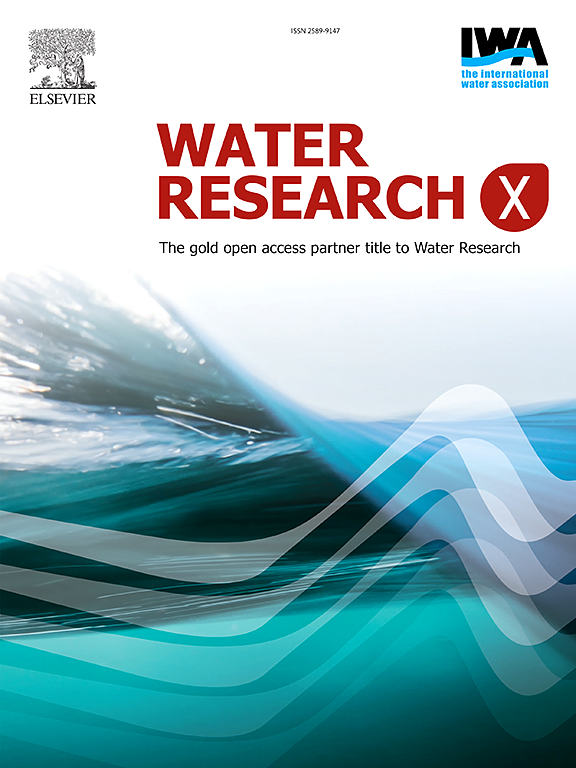水厂氧化亚氮定量方法选择的系统决策框架
IF 8.2
2区 环境科学与生态学
Q1 ENGINEERING, ENVIRONMENTAL
引用次数: 0
摘要
随着污水处理行业越来越重视减少一氧化二氮(N2O)的排放,越来越多的水务公司热衷于量化污水处理厂的实际N2O排放量。两种主要的基于单元的定量方法是基于液体N2O传感器的方法和基于气体通量罩的方法,这两种方法都允许在特定的监测位置进行实时测量。尽管它们被广泛使用,但没有明确的、基于证据的框架来帮助公用事业公司根据其特定需求选择最合适的方法。本研究通过开发一个系统的决策框架来解决这一差距,该框架考虑了关键因素的影响,包括植物覆盖(完全覆盖或开放表面)、曝气类型(扩散曝气或表面曝气)、配置(监测地点数量)、监测持续时间、成本和技术难度等。该框架结合了一个全面的多标准评估,以平衡五个基本标准,包括设备成本、消耗品成本、调试、维护和数据分析的复杂性。结果表明,液体法更适合监测地点少、监测时间短的情况。相比之下,基于气体的方法在需要高监测强度的场景中更有优势。对于中等强度的场景,选择基于气体的方法的可能性随着监测强度的增加而增加,决策高度依赖于分配给各因素的权重。研究结果还强调了在多标准评估过程之前,根据具体的操作需求、可用资源和技术能力确定标准和分数权重的重要性,这可能会相应地改变评估结果。该框架为公用事业公司优化一氧化二氮监测策略和支持减排提供了实用工具。本文章由计算机程序翻译,如有差异,请以英文原文为准。

A systematic decision-making framework for selecting nitrous oxide quantification methods in water utilities
With the growing emphasis on reducing nitrous oxide (N2O) emissions in the wastewater treatment sector, an increasing number of water utilities are keen to quantify the actual N2O emissions from sewage treatment plants. Two main unit-based quantification methods are the liquid N2O sensor-based method and the gas flux hood-based method, both of which allow for real-time measurement at specific monitoring locations. Despite their widespread use, there is no clear, evidence-based framework to help utilities choose the most suitable method for their specific needs. This study addresses this gap by developing a systematic decision-making framework that considers the impact of key factors, including plant covering (fully covered or open surface), aeration type (diffused aeration or surface aerator), configurations (number of monitoring locations), monitoring duration, cost and technical difficulties etc. The framework incorporates a comprehensive multi-criteria evaluation to balance five essential criteria, including equipment cost, consumable cost, commissioning, maintenance and complexity in data analysis. Results indicate that the liquid-based method is more suitable for scenarios with fewer monitoring locations and shorter durations. In contrast, the gas-based method proves more advantageous in scenarios requiring high monitoring intensity. For intermediate-intensity scenarios, the likelihood of selecting gas-based method increases with monitoring intensity, with the decision being highly dependent on the weighting assigned to the factors. The findings also highlight the importance of determining the weights of criteria and scores based on specific operational needs, available resources, and technical capacity prior to multi-criteria evaluation process, which may vary the evaluation results accordingly. This framework provides utilities with a practical tool to optimize N2O monitoring strategies and support emission reduction.
求助全文
通过发布文献求助,成功后即可免费获取论文全文。
去求助
来源期刊

Water Research X
Environmental Science-Water Science and Technology
CiteScore
12.30
自引率
1.30%
发文量
19
期刊介绍:
Water Research X is a sister journal of Water Research, which follows a Gold Open Access model. It focuses on publishing concise, letter-style research papers, visionary perspectives and editorials, as well as mini-reviews on emerging topics. The Journal invites contributions from researchers worldwide on various aspects of the science and technology related to the human impact on the water cycle, water quality, and its global management.
 求助内容:
求助内容: 应助结果提醒方式:
应助结果提醒方式:


